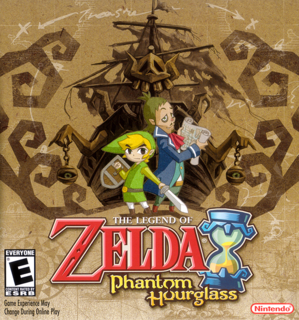Nifty controls aside, Phantom Hourglass travels a fun and well-worn path, never really taking any detours.
New controls make the game feel fresher than it really is; the Penguin people are totally cool; There's no end of the universe plot for once; Ganon's on the sidelines.
The Bad
Middling presentation has neither standout visuals nor standout audio; Storyline masks the same Zelda formula that's been used for nearly two decades; Short for a Zelda game; No difficulty whatsoever.
Story
It all boils down to the fact that there's nothing really new here in the story department. For those that have traveled roads long worn in the Zelda franchise, Phantom Hourglass is of the same material you've always been used to. Tetra - Princess Zelda's re-imagining introduced in Wind Waker - and her good friend Link have set off to explore the boundless oceans after saving the memory of Hyrule and settling Gandondorf's evil scheme once and for all (well, until he brings himself back from the dead...again. It will happen. Trust me.). But in typical Legend of Zelda fashion, the duo don't get very far before Tetra is captured by the devious Ghost Ship and Link is forced once again to set off in search of his beloved princess. The story doesn't really get much deeper than this. Unlike previous Zelda games, there's no real plot that threatens the very fabric of the universe. The goal of the game is simply to rescue Tetra from her rather bleak outlook at the hands of the terrifying Ghost Ship. Sure, Link will be thrown around from location to location in search of various objects that will undoubtedly either weaken of reveal some sort of evil power, but if you're looking for something that blazes new ground - you're not going to find it. As for how long the story is...dedicated DSers should be able to finish the game in around six to eight hours. I capped in at just under eight.
Gameplay
Where Phantom Hourglass really shines is in its gameplay. I mean, after all this is the first true Legend of Zelda game created for Nintendo's new generation of systems. The biggest thing you'll notice is that the ABXY buttons don't do anything. You can press them all you want and you won't get anywhere. Nope, that's not how you do things. Instead, you use the stylus. Want to swing your sword? Draw a quick line between Link and his foe and he'll slash. How about that fancy swirly attack that Link is so famous for? To do that you just draw a quick circle around Link and watch him go. To move link, you drag the stylus around the screen which will make Link follow his little fariry/pointer companion. The further towards the edge of the screen you drag the stylus, the faster link will run. Of course, it's not these basic commands that make Phantom Hourglass what it is. It's the items like the Bombchus and the Boomerang. Remember in Ocarina of Time when the Bombchus pretty much went in a straight line? Well, in Phantom Hourglass they follow the path you draw for them on the bottom screen. Same thing with the Boomerang. This adds some twists to the game's puzzles and makes for some interesting challenges along the wall - although these challenges will never be anything to wrack your brain over. Of course, you're probably wondering about all that water you keep hearing about. Well, in true Wind Waker sequel style, Phantom Hourglass takes place in a world filled with islands and a whole lot of water. Fortunately, travelling between islands in Phantom Hourglass is much easier (and faster) than it was in Wind Waker. All you do is simply pull out your sea chart, draw a course with your stylus, and hit the Go button on your ship's little nav panel. Then just let it go.
While all of these touch mechanics may sound like they take a bit of getting used to, there's really no learning curve here. Phantom Hourglass is in no way a hard game and it almost feels as though Nintendo toned down the difficulty in this first touch release so that people new to the franchise could get their bearings without too much of a hassle. Many of the dungeons puzzles are relatively easy to figure out and none of the require any outright notes or backtracking. Phantom Hourglass seems to be designed as smooth sailing from start to finish.
Presentation
There's not much to talk about in this department. In keeping with Wind Waker's art style, Phantom Hourglass makes use of a lot of cel-shading techniques and swirlies. In most cases, the game doesn't different from the presentation given in The Minish Cap - Nintendo's Wind Waker-esque sequel for the Game Boy Advance. Like most of the Zelda handheld adventures, the world looks like it was built for midgets - there's nothing incredibly tall here and the maps are broken up into sections and rarely presented in one continuous screen. The game's color pallete is pretty conservative as well, there's nothing blindinly bright, but nor is there anything seedingly dark. the game kind of middles out in the color department. As for audio, this is your typical Zelda handheld fair. It seems as though Nintendo kind of took most of the basic sounds from Wind Waker and Minish Cap and kind of threw them into the package. There are some new music pieces here and there, but nothing that will wow you.

